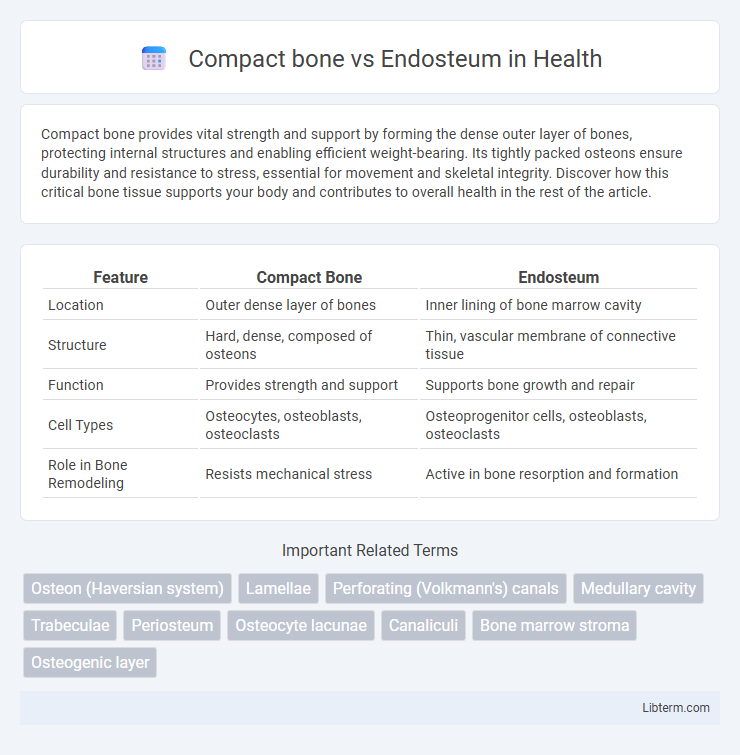Compact bone provides vital strength and support by forming the dense outer layer of bones, protecting internal structures and enabling efficient weight-bearing. Its tightly packed osteons ensure durability and resistance to stress, essential for movement and skeletal integrity. Discover how this critical bone tissue supports your body and contributes to overall health in the rest of the article.
Table of Comparison
| Feature | Compact Bone | Endosteum |
|---|---|---|
| Location | Outer dense layer of bones | Inner lining of bone marrow cavity |
| Structure | Hard, dense, composed of osteons | Thin, vascular membrane of connective tissue |
| Function | Provides strength and support | Supports bone growth and repair |
| Cell Types | Osteocytes, osteoblasts, osteoclasts | Osteoprogenitor cells, osteoblasts, osteoclasts |
| Role in Bone Remodeling | Resists mechanical stress | Active in bone resorption and formation |
Introduction to Compact Bone and Endosteum
Compact bone is a dense, structural tissue forming the outer layer of bones, providing strength and protection, while the endosteum is a thin, vascular membrane lining the inner surfaces of the bone, including the medullary cavity and trabeculae. Compact bone consists mainly of tightly packed osteons, which contain concentric lamellae surrounding central canals with blood vessels and nerves. The endosteum contains osteoprogenitor cells essential for bone growth, remodeling, and repair, playing a critical role in maintaining bone health.
Structural Overview of Compact Bone
Compact bone, also known as cortical bone, is characterized by its dense, tightly packed structure that provides strength and support to the skeletal system. It consists primarily of osteons or Haversian systems, cylindrical units that contain a central canal housing blood vessels and nerves, surrounded by concentric lamellae of mineralized matrix. Unlike the delicate, vascularized endosteum lining the medullary cavity, compact bone forms the robust outer layer of bones, crucial for weight-bearing and resistance to mechanical stress.
Anatomy and Function of the Endosteum
The endosteum is a thin, vascularized membrane lining the inner surfaces of compact bone and the medullary cavity, playing a crucial role in bone remodeling and growth. It contains osteoprogenitor cells essential for bone repair and regeneration, contrasting with the dense and rigid structure of compact bone that provides mechanical strength. Unlike compact bone's solid matrix, the endosteum facilitates nutrient exchange and houses cells that regulate bone resorption and formation.
Key Differences Between Compact Bone and Endosteum
Compact bone is a dense, rigid tissue forming the outer layer of bones, providing structural support and protection, whereas the endosteum is a thin, vascular membrane lining the inner surface of bones, including the medullary cavity. Compact bone consists mainly of osteons or Haversian systems, which are cylindrical structures responsible for nutrient delivery and mechanical strength, while the endosteum contains osteoprogenitor cells essential for bone growth, repair, and remodeling. The key differences lie in their structure, function, and location; compact bone forms the hard exterior, whereas the endosteum acts as a critical interface between bone tissue and bone marrow.
Cellular Composition: Compact Bone vs Endosteum
Compact bone consists primarily of osteocytes embedded within a dense matrix of collagen fibers and hydroxyapatite, providing structural strength. The endosteum is a thin, cellular layer lining the inner surfaces of compact bone and contains osteoprogenitor cells, osteoblasts, and osteoclasts responsible for bone growth, remodeling, and repair. This distinct cellular composition allows compact bone to serve as a supportive framework while the endosteum maintains bone homeostasis and regeneration.
Roles in Bone Growth and Remodeling
Compact bone provides structural support and strength through dense, organized osteons that facilitate resistance to mechanical stress. The endosteum, a thin vascular membrane lining the inner bone surfaces, houses osteoblasts and osteoclasts essential for bone growth, repair, and remodeling activities. Together, compact bone maintains rigidity while the endosteum actively regulates bone modeling and remodeling by balancing bone formation and resorption.
Vascularization and Nutrient Supply
Compact bone is highly vascularized through Haversian canals, which contain blood vessels that supply oxygen and nutrients essential for bone maintenance and repair. The endosteum, a thin vascular membrane lining the inner surface of the medullary cavity, houses osteoprogenitor cells and contributes to nutrient exchange between bone marrow and compact bone. Efficient vascular networks in both compact bone and the endosteum are critical for sustaining bone metabolism and facilitating healing processes.
Compact Bone and Endosteum in Bone Repair
Compact bone provides structural strength and serves as a key framework during bone repair by forming new bone tissue to replace damaged areas. The endosteum, a thin vascular membrane lining the inner surface of compact bone, plays a critical role in bone healing by harboring osteoprogenitor cells that differentiate into osteoblasts for bone regeneration. Together, compact bone and endosteum coordinate to restore bone integrity and facilitate efficient remodeling after injury.
Diseases and Disorders Affecting Compact Bone vs Endosteum
Diseases affecting compact bone commonly include osteoporosis and osteomyelitis, which lead to decreased bone density and infection within the dense outer layer, respectively. The endosteum, lining the inner surface of bones, is often involved in conditions such as endosteal sclerosis and certain bone marrow disorders that disrupt normal bone remodeling and hematopoiesis. Both structures are critical in maintaining bone health, and damage to either can result in compromised bone strength and increased fracture risk.
Summary: Clinical Importance of Compact Bone and Endosteum
Compact bone provides essential structural support and protection, forming the dense outer layer of bones that withstands mechanical stress and facilitates movement. The endosteum, a thin vascular membrane lining the medullary cavity, plays a critical role in bone growth, repair, and remodeling by housing osteoprogenitor cells and mediating mineral homeostasis. Clinically, damage or disease affecting compact bone can lead to fractures and structural instability, while endosteal dysfunction impairs bone healing and contributes to conditions such as osteoporosis.
Compact bone Infographic

 libterm.com
libterm.com